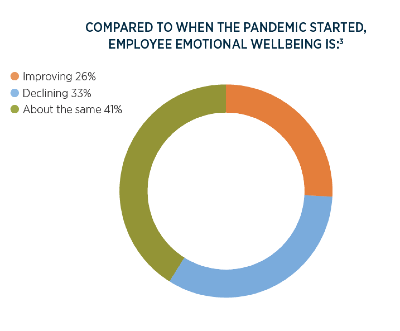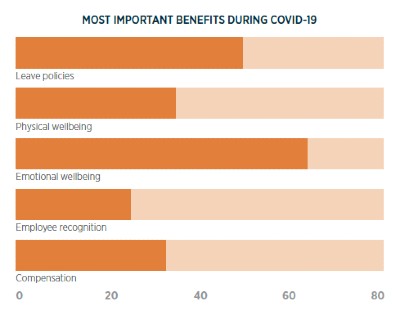Author: Kathleen Schulz, MS, CHES
COVID-19 has taken an emotional toll on employees, and has compounded stress and loneliness in an already stressed and increasingly lonely workforce. The continued fear, uncertainty, upended routines, financial pressure, and challenge for parents trying to tackle work and child care from home has impacted our daily emotions – reducing our joy, increasing our stress and magnifying our feelings of loneliness.

Almost 20%1 of us, pre-pandemic, would experience some type of mental and/or behavioral health issue in a given year. The costs to us personally, and to businesses… are staggering as we think about the impact on productivity, absenteeism, presenteeism, healthcare costs (which can be 2-3x higher for those with a MH/BH issue2), and even employee engagement can be negatively affected if the employee perceives the work environment as part of what’s causing them stress. Now 6 months into the pandemic, specifically in the Non-Profit industry, the stress of all things related to COVID-19, plus the political and community unrest we’re experiencing continues to drain employee emotional wellbeing with 74% of responders to a recent Gallagher Pulse Survey stating that employee emotional wellbeing has declined or stayed the same (which for many was not very good) compared to when the pandemic started.

Nonprofit Leaders Are Noticing
In the Nonprofit industry, 78%3 of recent Pulse Survey responders indicated that their C-Suite is concerned about the impact of stress and burnout on their organization. That recognition has fueled emotional wellbeing to emerge as the most important benefit to total rewards planning during COVID-19.
It’s All Connected
COVID-19 has presented unprecedented challenges, but a silver lining may be the advancement of conversations regarding emotional wellbeing, and a new understanding for how employee wellbeing and organizational wellbeing connect. The epidemic level of stress people are experiencing can reduce their human resiliency – a person’s ability to bounce back from adversity. Lower resiliency can impact loneliness. Increased loneliness can raise the potential for burnout, driving down employee engagement, which is lined to overall wellbeing. People bring the most to work when they feel connected to the mission and people around them. A company that fosters social connections as a strategic priority and values the positive emotions around compassion, joy and caring is more likely to experience greater productivity and engagement, while protecting against illness and burnout.

